Methyl isobutyl carbinol
Agent Name
Methyl isobutyl carbinol
Alternative Name
Methyl amyl alcohol
CAS Number
108-11-2
Formula
C6-H14-O
Major Category
Solvents

Synonyms
Methyl amyl alcohol; (+-)-4-Methyl-2-pentanol; 1,3-Dimethylbutanol; 2-Methyl-4-pentanol; 2-Pentanol, 4-methyl-; 3-MIC; 4-Methyl-2-amyl alcohol; 4-Methyl-2-pentyl alcohol; 4-Methylpentanol-2; 4-Metilpentan-2-olo [Italian]; 4-Pentanol, 2-methyl-; Alcohol methyl amylique [French]; Alcool methyl amylique [French]; Isobutylmethylcarbinol; Isobutylmethylmethanol; M.I.B.C.; MAOH; MIBC; MIC; Methyl amyl alcohol; Methyl isobutyl carbinol; Methyl-isobutylkarbinol [Czech]; Methylisobutyl carbinol; Methylisobutylcarbinol; Metilamil alcohol [Italian]; dl-Methylisobutylcarbinol; [ChemIDplus] UN2053
Category
Alcohols (<C12)
Description
Colorless liquid with a mild odor; [NIOSH]
Sources/Uses
Used primarily in the production of additives for anti-wear and corrosion inhibitors; Used secondarily as a flotation agent (copper ores, coal and tar sand mining); Also used as an additive to surface coatings and solvent to improve binder softness; Usually used in closed systems except as a floating agent; [ACGIH, 2020]
Comments
In acute animal studies, high concentrations induce narcosis and anesthesia. [ACGIH] Inhalation of high concentrations can cause CNS depression; A skin, eye, and respiratory tract irritant; [ICSC]
Biomedical References
Exposure Assessment
Skin Designation (ACGIH)
No
TLV (ACGIH)
20 ppm
STEL (ACGIH)
40 ppm
PEL (OSHA)
25 ppm
MAK
20 ppm
IDLH (NIOSH)
400 ppm
Excerpts from Documentation for IDLHs
Human data: Eye irritation has occurred after exposures to 50 ppm for 15 minutes [Silverman et al. 1946].
Vapor Pressure
2.8 mm Hg
Odor Threshold Low
0.01 ppm
Odor Threshold High
1 ppm
Lethal Concentration
LCLo (rat) = 2,000 ppm/4H
Explanatory Notes
Odor threshold from "Quick Guide: The Electronic NIOSH Pocket Guide to Chemical Hazards"; Flash point = 105 deg F; VP from HSDB;
NFPA
high ambient temp required
Adverse Effects
Neurotoxin
Acute solvent syndrome
Diseases, Processes, and Activities Linked to This Agent
Diseases
Occupational diseases associated with exposure to this agent: